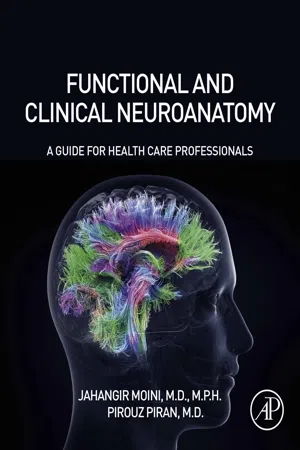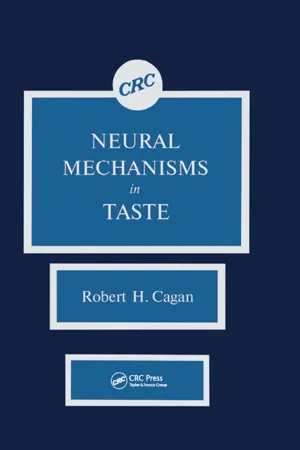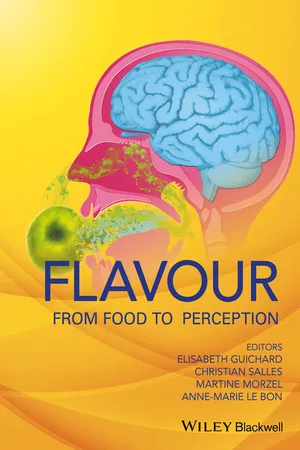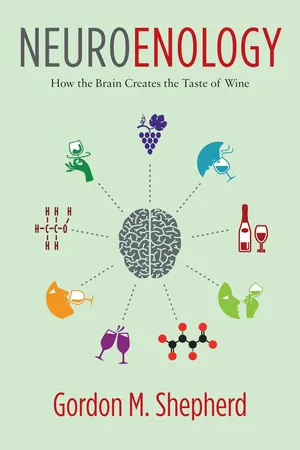Psychology
Gustatory System
The gustatory system refers to the sensory system responsible for the perception of taste. It involves the detection of chemicals in food and drink by taste receptors located on the tongue and in the mouth. These receptors send signals to the brain, allowing individuals to experience the sensations of sweet, sour, salty, bitter, and umami tastes.
Written by Perlego with AI-assistance
Related key terms
5 Key excerpts on "Gustatory System"
- eBook - ePub
- Susan A. Lanham-New, Ian A. MacDonald, Helen M. Roche(Authors)
- 2011(Publication Date)
- Wiley-Blackwell(Publisher)
All food enters the body through the mouth. From the time of birth, we select what is beneficial to eat and reject that which will cause ill-health. The food senses have evolved to aid this decision-making process. In our modern world, the protective role of sensation is primarily to detect spoiled or tainted foods, as few now roam the countryside hunting, gathering and sampling unusual ‘food’. However, we retain the psychological foundations upon which a ‘safe and nutritious’ diet from initially unknown foods is built, where we observe others, are encouraged to taste by information, sample by tasting and await the post-ingestion physiology consequences (without intention). This learning, often by association, results in a dietary habit of consuming foods with familiar sensory properties, but which may evolve slowly as we age. Within the range of palatable foods in the marketplace, subtle differences in taste, smell or texture can therefore have dramatic influence on individual preferences, ultimately determining quantity consumed, repeated intake and potential nutrition. Individual preferences are underpinned by genetics and determined by the impact of environment and experiences from early life.The food senses have independent physiology and will be considered separately in this chapter. However, during consumption, these distinct sensory modalities interact to determine palatability and few consumers make any distinction. In fact, palatability is determined by a combination of all sensations relevant to food acceptability, including taste, smell, warmth or cold, touch, texture, pain and even visual sensations. In this chapter it will therefore be necessary to consider the perception of the senses together, particularly with regard to the understanding of sensory preferences.9.2 The taste systemUnlike vision or olfaction, taste is a proximal sense, meaning that the primary stimulus for taste must make contact with the taste receptors, therefore the process of tasting begins in the oral cavity, primarily on the tongue. Taste receptors are stimulated by contact with liquid compounds, creating perceptions that endow distinctive taste qualities such as sweet, salty, sour, bitter and umami to these compounds.Anatomy and physiology of the taste systemTaste receptors, located primarily on the tongue and soft palate, are termed taste buds (Figure 9.1 - eBook - ePub
Functional and Clinical Neuroanatomy
A Guide for Health Care Professionals
- Jahangir Moini, Pirouz Piran(Authors)
- 2020(Publication Date)
- Academic Press(Publisher)
electrogustometers that are used to measure taste intensity, and to determine detection and recognition thresholds of taste and olfactory stimuli. However, these are only used in extreme cases.Focus on the “umami” or “savory” sense of tasteThe Japanese term “umami” is equivalent to the English word “savory.” It has been recognized as the fifth basic taste, in addition to the better-known tastes of sweet, sour, bitter, and salty. Savory dishes evoke pleasant emotions, and this form of taste is a signal that a food source is rich in protein. The sensory cells specifically involved in this form of taste were originally discovered in Japan in 1910.Section review- 1. Where is the distribution of taste buds?
- 2. What are the physiological characteristics of taste buds?
- 3. What is the location of the gustatory centers within the brain?
Clinical considerations
There are many conditions of the limbic, olfactory, and Gustatory Systems that must be understood. Limbic system conditions include emotional disturbances, which may be due to hallucinations or pain, emotional lability, spasmodic (pseudobulbar) emotional disturbances, anger, violent behaviors, rage due to temporal lobe seizures, rage without seizures, violence due to neurologic diseases, aggressiveness due to encephalopathies and drug intoxication, apathy, placidity, alterations in sexuality, anxiety, euphoria, fear, and differential limbic diagnoses. Olfactory system conditions include anosmia, parosmia, hallucinations, and agnosia. Gustatory System conditions include ageusia, hypogeusia, and dysgeusia.Emotional disturbances of the limbic structures
Regarding the limbic system, there are a variety of neurological factors related to emotional disturbances. Illusions and hallucinations are classified as perceptual abnormalities, while delusions are classified as cognitive derangements. Emotional lability as well as pathologic laughing and crying, which is known as the pseudobulbar state - eBook - ePub
- Robert H. Cagan(Author)
- 2020(Publication Date)
- CRC Press(Publisher)
Boudreau and colleagues 125 have suggested that the peripheral Gustatory System is composed of three or four basic modules, each specialized to process a specific taste. Each module within the Gustatory System would consist of a large population of receptor cells, with unique chemical sensitivities, that converge on a smaller number of sensory neurons. The identifying taste quality of the module would depend on the species, influenced by its particular physiological needs and dietary patterns. For example, based on chorda tympani neuron responses to a broad range of stimuli, rats seem to possess modules for sugars and amino acids, as well as Na +. The absence of a specific Na + module in cats is consistent with their carnivorous feeding patterns, while the lack of an amino acid module in goats is consistent with their vegetarian feeding patterns. 125 Furthermore, Chang and Scott 174 provided strong evidence that sweet-sensitive neurons in the NST can be modified by experience, much like salt-sensitive neurons after sodium deprivation. In Chang and Scott’s study, 174 three different groups of rats received training before electrophysiological recording. The treatment group drank a sodium saccharin solution and then was injected with LiCl to induce a conditioned taste aversion. One control group drank the same saccharin solution, but was injected with saline, while the second control group drank water and was injected with LiCl. The experimental group acquired an aversion to saccharin, while the other two groups controlled for the effects of just tasting saccharin or being made sick by a LiCl injection. Chang and Scott found that only a subpopulation of taste neurons was affected by conditioning - eBook - ePub
Flavour
From Food to Perception
- Elisabeth Guichard, Christian Salles, Martine Morzel, Anne-Marie Le Bon(Authors)
- 2016(Publication Date)
- Wiley-Blackwell(Publisher)
Chapter 3 The vertebrate Gustatory System Maik Behrens & Wolfgang MeyerhofDepartment Molecular Genetics, German Institute of Human Nutrition Potsdam-Rehbruecke, Nuthetal, Germany3.1 Introduction
Vertebrates use the sense of taste to detect foods rich in macronutrients and electrolytes and poor in potentially harmful compounds. Taste reception is limited to the five basic taste qualities sweet, bitter, and umami (the taste of L-glutamate in humans and several L-amino acids in rodents) which are mediated by G protein-coupled receptors of the taste 1 (TAS1R) and taste 2 receptor (TAS2R) families, and sour and salty transmitted presumably by ion channels (for a recent review see Liman et al. 2014). Recent studies hint at a gustatory component involved in the perception of fat constituents (for a recent review, see Mattes 2011). The existence of several fat taste receptor candidates for example, potassium channels (Gilbertson et al. 1997), the fatty acid transporter CD36 (Fukuwatari et al. 1997, Laugerette et al. 2005), and G protein-coupled fatty acid receptors (Cartoni et al. 2010, Galindo et al. 2012b, Matsumura et al. 2007) as well as suggested mechanisms for appropriate stimulus presentation (Kawai and Fushiki 2003, Kulkarni and Mattes 2013, Pepino et al. 2012, Voigt et al. 2014) have also been reported. However, further research will be required to evaluate whether stimulus recognition, information transmission, and central processing of fat constituents indeed qualifies the orosensory perception of fat as an additional taste modality or not. It is therefore not considered in this chapter.Whereas sweet and umami taste indicates the presence of energy-rich nutrients in the form of carbohydrates and amino acids/proteins in the oral cavity, sour and bitter taste signal potentially unripe or bacterially spoiled food or even the presence of toxic substances (Lindemann 1996). The detection of salts in the ingested food or consumed water is important for the maintenance of the electrolyte balance of the body fluids. Because the different taste qualities signal the presence of beneficial and harmful food items, they evoke attraction to sweet and umami stimuli or aversion to sour and bitter tastants. Thus, our taste system, in concert with our other senses such as vision, touch, and, especially smell, is exquisitely prepared to guide the consumption of foods towards the ingestion of healthy, nutritionally relevant food items (Galindo et al. 2012a). Tragically, it appears that this sophisticated innate control system of food choice which evolved during the evolution of species is obviously not well adapted to the situation in well-developed industrialized countries. The easy access to food here results in the enforcement of unhealthy over-eating of high-caloric diets associated with high incidence of obesity and metabolic syndrome in man and pets (Breslin 2013). Therefore, understanding taste perception provides an important access to potential therapeutic options of nutrition-associated diseases. - eBook - ePub
Neuroenology
How the Brain Creates the Taste of Wine
- Gordon Shepherd(Author)
- 2016(Publication Date)
- Columbia University Press(Publisher)
The application to wine is a hypothesis. A casual wine taster can ignore the specific brain regions and concentrate on the fact that the perception of wine flavor is likely due to successive levels of neural processing of multiple parallel sensory inputs, with the output distributed to different behavioral actions. This provides a framework for neuroenology that enables one to relate brain imaging and brain recordings to the wine experience. We focus on several of the critical steps in this network. The Olfactory Cortex Begins to Integrate Smell with Taste From the olfactory bulb, the output cells send their long axons over the surface of the olfactory cortex to make widespread connections to the pyramidal cells there, creating the “content addressable memory” of the smell stimulus, as discussed in chapter 9. The processing of odor input in the olfactory cortex uses the same mechanisms as orthonasal input. But as we have emphasized, retronasal activation is accompanied by the activation of all the other sensory pathways coming from the mouth. Since one of the main functions of the brain is to enable different systems not only to do their own thing but also to interact with other systems, we should not be surprised if this is true of the flavor system as well. And this is indeed the case. Since the 1950s, many studies have focused on the effects of the taste system on the olfactory system and vice versa. Most of these studies have shown that tastants have a larger effect on smells than smells have on tastes. The increase is referred to as flavor enhancement. A study conducted in 2012 by Barry Green and his colleagues at the Pierce Laboratory in New Haven tested subjects with solutions containing odorants such as vanillin (vanilla odor), citral (lemon odor), and furaneol (strawberry odor) and tastants such as sucrose, salt, and citric acid. The subjects sampled these separately and in mixtures
Learn about this page
Index pages curate the most relevant extracts from our library of academic textbooks. They’ve been created using an in-house natural language model (NLM), each adding context and meaning to key research topics.




